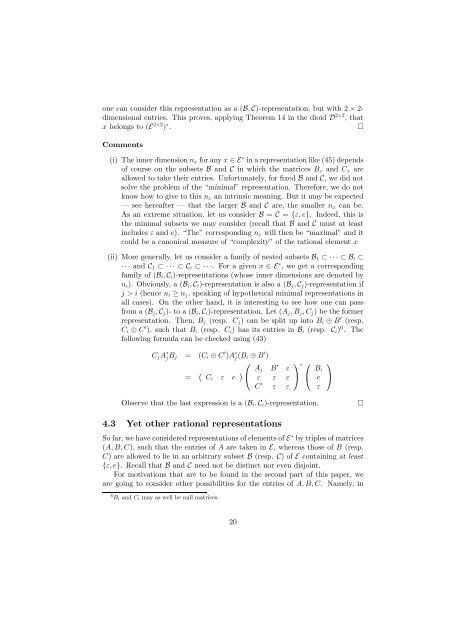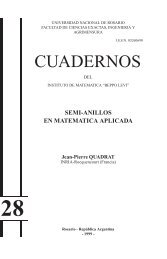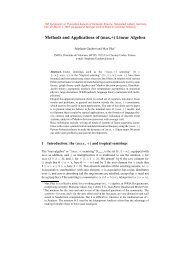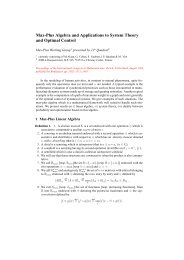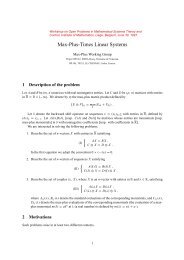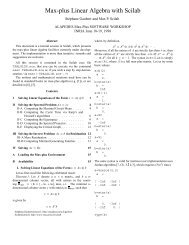View - Jean-Pierre QUADRAT - Free
View - Jean-Pierre QUADRAT - Free
View - Jean-Pierre QUADRAT - Free
Create successful ePaper yourself
Turn your PDF publications into a flip-book with our unique Google optimized e-Paper software.
one can consider this representation as a (B, C)-representation, but with 2 × 2-dimensional entries. This proves, applying Theorem 14 in the dioid D 2×2 , thatx belongs to (E 2×2 ) ∗ .□Comments(i) The inner dimension n x for any x ∈E ∗ in a representation like (45) dependsof course on the subsets B and C in which the matrices B x and C x areallowed to take their entries. Unfortunately, for fixed B and C, we did notsolve the problem of the “minimal” representation. Therefore, we do notknow how to give to this n x an intrinsic meaning. But it may be expected— see hereafter — that the larger B and C are, the smaller n x can be.As an extreme situation, let us consider B = C = {ε, e}. Indeed, this isthe minimal subsets we may consider (recall that B and C must at leastincludes ε and e). “The” corresponding n x will then be “maximal” and itcould be a canonical measure of “complexity” of the rational element x(ii) More generally, let us consider a family of nested subsets B 1 ⊂···⊂B i ⊂··· and C 1 ⊂···⊂C i ⊂ ···. For a given x ∈E ∗ , we get a correspondingfamily of (B i , C i )-representations (whose inner dimensions are denoted byn i ). Obviously, a (B i , C i )-representation is also a (B j , C j )-representation ifj>i(hence n i ≥ n j , speaking of hypothetical minimal representations inall cases). On the other hand, it is interesting to see how one can passfrom a (B j , C j )- to a (B i , C i )-representation. Let (A j ,B j ,C j ) be the formerrepresentation. Then, B j (resp. C j ) can be split up into B i ⊕ B ′ (resp.C i ⊕ C ′ ), such that B i (resp. C i ) has its entries in B i (resp. C i ) 6 . Thefollowing formula can be checked using (43)C j A ∗ jB j = (C i ⊕ C ′ )A ∗ j(B i ⊕ B ′ )⎛⎞= ( C i ε e ) A j B ′ ∗ ⎛ε⎝ ε ε ε ⎠ ⎝C ′ ε εB ieε⎞⎠Observe that the last expression is a (B i , C i )-representation.□4.3 Yet other rational representationsSo far, we have considered representations of elements of E ∗ by triples of matrices(A, B, C), such that the entries of A are taken in E, whereas those of B (resp.C) are allowed to lie in an arbitrary subset B (resp. C) ofE containing at least{ε, e}. Recall that B and C need not be distinct nor even disjoint.For motivations that are to be found in the second part of this paper, weare going to consider other possibilities for the entries of A, B, C. Namely, in6 B i and C i may as well be null matrices.20


